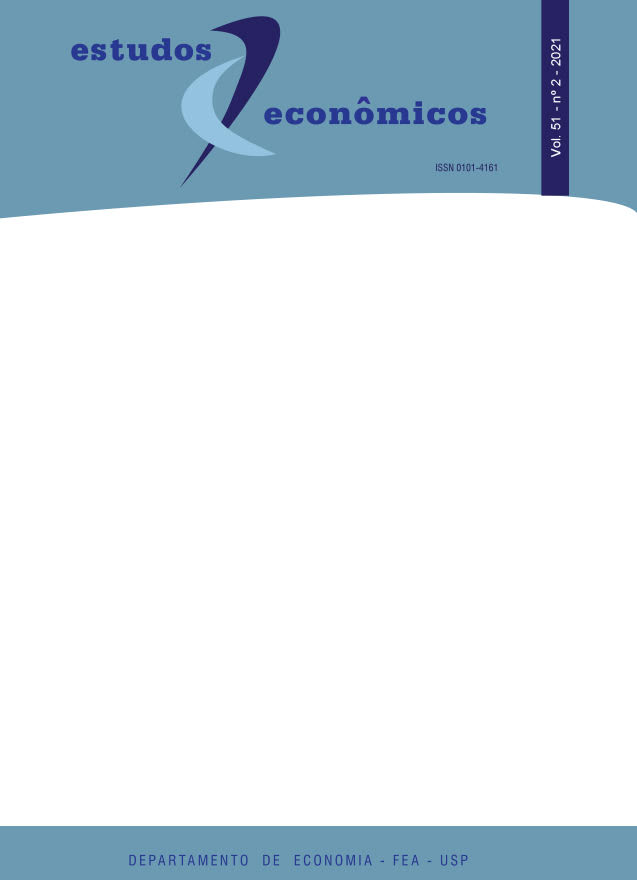O Impulso de multiplicador fiscal: implementação e evidência para o Brasil
DOI:
https://doi.org/10.1590/0101-41615121mpcrPalavras-chave:
Multiplicador fiscal, Investimento público, Impulso fiscalResumo
O efeito macroeconômico da política fiscal é objeto de amplo debate na literatura econômica e, apesar disso, não há incorporação desses efeitos nos indicadores sintéticos de acompanhamento macroeconômico. Este artigo analisa a introdução de estimativas desagregadas de multiplicadores fiscais no cálculo do impulso fiscal estrutural. Os resultados indicam maior acurácia no acompanhamento da política fiscal e também explica que a evidência de baixos multiplicadores agregados é compatível com elevados multiplicadores de investimento público e das transferências de renda. Essa situação prevalece quando ocorrem variações expressivas em despesas com baixo multiplicador ao longo do ciclo. Nesse caso, estimativas de multiplicadores fiscais pequenos podem constituir evidência de que a política fiscal foi mal implementada ao invés de demonstrar uma eventual ineficácia.
Downloads
Referências
Auerbach, A.; Gorodnichenko, Y. 2012. “Measuring the output responses to fiscal policy”. American Economic Journal: Economic Policy 4, no. 2: 1-27.
Auerbach, A. 2019. “Fiscal policy”. In: Blanchard, O.; Summers, L (ed). Evolution or revolution: rethinking macroeconomic policy after the great recession. The MIT Press.
Blanchard, O. e Perroti, R. 2002. “An empirical characterization of the dynamic effects of changes in government spending and taxes on output.” Quarterly Journal of Economics 117, no. 4: 1329-1368.
Carnot, N., De Castro, F. 2015. “The discretionary fiscal effort: an assessment of fiscal policy and its output effect”. Hacienda Pública Española 215: 63.
De Long, B. e Summers, L. 2012. “Fiscal policy in a depressed economy”. Brookings Papers on Economic Activity, Spring, 233-297.
Dupaigne, M.; Fève, P. 2016. “Persistent government spending and fiscal multipliers: The investment-channel”. European Economic Review 89: 425-453.
Eggertsson, G. e Krugman, P. 2012. “Debt, deleveraging, and the liquidity trap: A Fisher-Minsky-Koo approach”. Quarterly journal of economics 127, no 3: 1469-1513.
Galí, J., Lópes-Salido, D. e Vallés, J. 2007. “Understanding the effects of Government spending on consumption”. Journal of the European Economic Association 5, no 1: 227-270.
Gobetti, S.; Orair, R.; Dutra, F. 2018. Resultado estrutural e impulso fiscal: aprimoramentos metodológicos. Texto para Discussão IPEA 2405.
Grudtner, V., Aragon, E. 2017. “Multiplicador dos gastos do governo em períodos de expansão e recessão: evidências empíricas para o Brasil”. Revista Brasileira de Economia 71, no. 3: 321-345.
Hall, R. 2009. “By how much does GDP rise if the government buys more output? Brookings Papers on Economic Activity, Fall, 183-249.
Hagemann, R. 1999. “The structural budget balance: The IMF’s methodology”. IMF working paper no 95, July.
Huidrom, R., Kose, M., Lim, J. 2016. “Do fiscal multipliers depend on fiscal positions?” CAMA working paper, 35. Crawford School of Public Policy. Australian National University.
Ilzetzki, E., Mendoza, E., e Végh, C. 2013. “How big (small) are fiscal multipliers”. Journal of Monetary Eco-nomics 60, no 2: 239-254.
Lledó, V., Yoon, S., Fang, X., Mbaye, S., Kim, Y. 2017. “Fiscal rules at a glance”. IMF Background Note, 2017.
Disponível em: < https://www.imf.org/external/datamapper/fiscalrule/Fiscal%20Rules%20at%20a%20Glance%20-%20Background%20Paper.pdf>. Acesso em: 5 mai. 2019.
Oliveira, V. 2018. “Multiplicadores fiscais de gastos e tributos: uma abordagem DSGE para a economia brasileira”. Tese de Doutorado: Universidade São Paulo. Disponível em: <https://www.teses.usp.br/teses/disponiveis/12/1/tde15082018-112246/pt-br.php> Acesso em 2 fev. 2019.
Orair, R.; Siqueira, F.; Gobetti, S. 2016. “Política fiscal e ciclo econômico: uma análise baseada em multiplicadores do gasto público”. XXI Prêmio do Tesouro Nacional.
Perroti, R. 2014. “Fiscal policy in recesions”. In: Blanchard, O. e Akerlof, J. (ed). What we have learned? Macroeconomic policy after the crisis. The MIT Press.
Pires, M. C. C. 2017. “Política Fiscal e ciclos econômicos: teoria e a experiência recente”. 1a edição. Rio de Janeiro.
Pires, M. C. C. 2014. “Política fiscal e ciclos econômicos no Brasil”. Economia Aplicada 18: 69-90.
Ramey, V. 2019. “Ten years after the financial crisis: What have we learned from the renaissance in fiscal research?” Journal of Economic Perspectives 33, no. 2: 89-114.
Ramey, V. e Zubairy, S. 2018. “Government spending multipliers in good times and in bad: Evidence from U.S. historical data”. Journal of political economy 126, no 2: 850-901.
Romer, C. e Romer, D. 2010. “The macroeconomic effects of tax changes: estimates based on a new measure of fiscal shocks”. American Economic Review 100, no. 3: 763-801.
SPE. 2018. Nota Metodológica do Resultado Fiscal Estrutural. Brasília.
SPE. 2019. Boletim Resultado Fiscal Estrutural. Brasília.
Sheiner, L. e Belz, S. 2019. The Hutchins Center’s fiscal impact measure. Brookings Institution. Report, July.
Disponível em: https://www.brookings.edu/research/the-hutchins-centers-fiscal-impact-measure/
Downloads
Publicado
Edição
Seção
Licença
Copyright (c) 2021 Manoel Carlos Castro Pires, Carolina Resende

Este trabalho está licenciado sob uma licença Creative Commons Attribution-NonCommercial 4.0 International License.
A submissão de artigo autoriza sua publicação e implica o compromisso de que o mesmo material não esteja sendo submetido a outro periódico.
A revista não paga direitos autorais aos autores dos artigos publicados.





 Atualizado em 14/08/2025
Atualizado em 14/08/2025